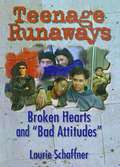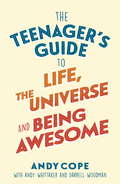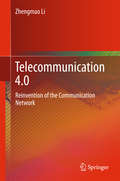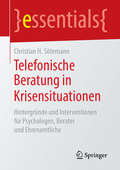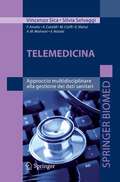- Table View
- List View
Teenage Runaways: Broken Hearts and "Bad Attitudes"
by Laurie SchaffnerTeenage Runaways: Broken Hearts and “Bad Attitudes” uncovers the perspectives of actual teenage runaways to help professionals, parents, and youths understand the widespread social problem of “last resort” behavior. You’ll learn the real reasons teenagers run away, and you’ll hear the anguished voices of the teenage runaways themselves, shattering the myth that only bad kids runaway.Teenage Runaways deflates popular misconceptions that runaways are incorrigible delinquents who want to leave home, that they make impulsive decisions to leave their families, and that they wish to never return. Reporting on a qualitative study of 26 runaways in a shelter in New England, this book reveals that many teenaged runaways leave home in search of safety and freedom from what they consider abusive treatment, whether physical, sexual, or emotional. In Teenage Runaways, you will discover valuable information about who these children are, why they are running away, and what you can do to help. Specifically, you will read about: why teenagers say they run away running away as “last resort behavior” what the experience of running away is like hope and desire for reconciliation with parents and family running away as a dynamic emotional experience for youths which reflects changes in their social bonds with peers, family, and adults in the educational, legal, and medical systems “emotional capital” from a heavily regulated authoritative environment Teenage Runaways provides you with a new understanding of teens in trouble to assist you in providing services to this needy and vulnerable population. First-hand accounts reveal the emotional motivations behind decisions to run away, such as 14 years-old Isabel who gives a painful account of what severe physical and sexual abuse feels like to an adolescent victim. Amy, also 14, tells her story of living with a mother who was extremely strict and betrayed her.
Teenage Sex and Pregnancy: Modern Myths, Unsexy Realities (Sex, Love, and Psychology)
by Mike A. MalesThis detailed, exhaustively documented account shows how and why just about everyone in today's teen pregnancy debate is wrong—often disastrously so.Teenage Sex and Pregnancy: Modern Myths, Unsexy Realities presents a unique view of its subject by analyzing the extensive myths and fears that surround discussion of teenage sex and pregnancy, including their relationship to popular culture, poverty, adult sexual behaviors, and anxieties toward the increasingly public roles of young women.Award-winning author Mike Males argues that today's discussions rely largely on falsehoods and the suppression of crucial realities. His work details a new view of popular culture as a largely beneficial feature of teens' lives and presents a carefully documented analysis demolishing destructive myths about the "new girl." Debunking popular arguments, he shows that the "teen sex" debate is mired in interest-group talking points that ignore difficult realities to advance politically attuned agendas. It's time, he writes, to modernize the discussion, recognizing that teens act in ways consistent with their interests, with the sexual behaviors of adults, and with the school and job opportunities afforded them.
Teenage Sexuality
by RokerFirst published in 1998. Routledge is an imprint of Taylor & Francis, an informa company.
Teenage Sexuality: "teenagers In The Family", "teenagers Under Stress", "teenagers And Sexuality", "teenagers And Divorce", "teenagers And Step-parents", "teenagers And Drugs", "teenagers And Alcohol", "teenage Suicide And Self-harm"
by RokerFirst published in 1998. Routledge is an imprint of Taylor & Francis, an informa company.
The Teenage World: Adolescents’ Self-Image in Ten Countries
by Daniel Offer Eric Ostrov K.I. Howard R. AtkinsonA Cross-National Study of Adolescent Self-Image Adolescence is not, as has been previously assumed, a developmental stage that was defined after the industrial revolution. There is substan tial historical evidence to suggest that adolescence and youth, as a stage, was recognized by the ancient Romans, Greeks, and even Egyp tians. The concept survived through the Dark Ages. In Le Grand Pro prietaire, written in 1556, it is stated: "The third age, which is called adolescence, . . . ends in the twenty-first year . . . and it can go on till thirty or thirty-five. The age is called adolescence because the person is big enough to beget children. In this age the limbs are soft and able to grow and receive strength and vigor from natural heat" (Aries, 1962, p. 21). The span of years devoted to adolescent development varies in different cultures and with different definitions. The term adolescence is no longer equivalent to pubescence. "Adolescence" is a psycho social-biological stage of development that corresponds to changes in many areas which accompany the transition from childhood to adult hood. The working definition of adolescence we use is the stage of life that starts with puberty and ends at the time when the person has attained a reasonable degree of independence from his parents. Once in high school or its equivalent, the vast majority of teenagers have al ready undergone the biological changes of puberty.
Teenagers and Technology (Adolescence and Society)
by Chris Davies Rebecca EynonThe popular media often presents a negative picture of young people and technology. From addiction to gaming, the distractions of the Internet, to the risks of social networking, the downsides of new technology in the lives of teenagers are often over-blown. Teenagers and Technology presents a balanced picture of the part played by technology in the lives of young people. Drawing on extensive interviews conducted over several years, this book offers a timely and non-sensational exploration of teenagers’ experiences and opinions about the digital technologies they use, desire and dislike. The book covers a range of topical subjects including: Social networking and online engagement in the wider social world Building online self-identity and group membership Technology in the home Developing technology skills in support of learning Drawing on technological resources in the journey towards adulthood. Grounded in what young people actually say about using new technology in their daily lives, Teenagers and Technology presents a picture in which young people have in some respects a unique relationship to technology, but one that is actually not exceptional or of a completely different order to how people in general relate to it. By providing a nuanced view on the topic, Teenagers and Technology counters the extreme accounts of ‘digital youth’, and exaggerated anxieties created by the mass media. It will be of interest to students and academics working in the fields of adolescent and Internet studies, along with education professionals, practitioners, teenagers and their parents.
Teenagers and Technology (Adolescence and Society)
by Chris Davies Rebecca EynonThe popular media often presents a negative picture of young people and technology. From addiction to gaming, the distractions of the Internet, to the risks of social networking, the downsides of new technology in the lives of teenagers are often over-blown. Teenagers and Technology presents a balanced picture of the part played by technology in the lives of young people. Drawing on extensive interviews conducted over several years, this book offers a timely and non-sensational exploration of teenagers’ experiences and opinions about the digital technologies they use, desire and dislike. The book covers a range of topical subjects including: Social networking and online engagement in the wider social world Building online self-identity and group membership Technology in the home Developing technology skills in support of learning Drawing on technological resources in the journey towards adulthood. Grounded in what young people actually say about using new technology in their daily lives, Teenagers and Technology presents a picture in which young people have in some respects a unique relationship to technology, but one that is actually not exceptional or of a completely different order to how people in general relate to it. By providing a nuanced view on the topic, Teenagers and Technology counters the extreme accounts of ‘digital youth’, and exaggerated anxieties created by the mass media. It will be of interest to students and academics working in the fields of adolescent and Internet studies, along with education professionals, practitioners, teenagers and their parents.
The Teenager’s Guide to Life, the Universe and Being Awesome: Super-charge your life
by Andy CopeCongratulations, you're already awesome. You are the best in the world at being you. The problem is that it's easy to forget!This book, by the authors of the extraordinary bestseller THE ART OF BEING A BRILLIANT TEENAGER, is a reminder that you are awesome and a prompt for bigger and better things. It asks not what you want from life, but what kind of person you want to be, exposing the key to planning for your future - building your best qualities so you can stand out and live a brilliant, energetic, successful life. You are already the best in the world at being you. This book will help you get even better.
Teenagers, HIV, and AIDS: Insights from Youths Living with the Virus (Sex, Love, and Psychology)
by Maureen E. Lyon Lawrence J. D'AngeloWho will want me now? It's a heart-wrenching question for teenagers infected with HIV.The number of HIV/AIDS-infected teenagers in the United States is increasing. Nearly 35,000 U.S. teenagers now have AIDS. Far more have been diagnosed with HIV, and an undetermined number have the virus and do not yet know. Each year, some 1,700 young people aged 13 to 24 are diagnosed with the ravaging end result of this infection: AIDS.In this volume, experts who work with HIV/AIDS-infected teenagers examine the psychological and social fallout compounding the frightening medical issues faced by adolescents who've received the diagnosis. Readers share the challenge with teens as they face the stigma of HIV/AIDS and the tough decisions about who to tell of their infection and when to do it. We learn the hard truth about health care, self care, and new treatment options for affected teens. And we read about the heartbreaking end-of-life care issues for dying adolescents. Perhaps most important, the authors offer resources teens and their families can turn to for information and support. And they explain what family, friends, teachers, and other professionals can do to help infected teens maximize their mental health and their quality of life.
Teens, Screens, and Social Connection: An Evidence-Based Guide to Key Problems and Solutions
by Alma Spaniardi Janki Modi AvariThis book explores the increasingly important intersection of the digital world and mental health in the lives of pediatric and young adult populations. Young people are spending a considerable amount of time on digital screen activities such as social media, texting, and online gaming. The vast majority of teens and pre-teens have access to computers and smartphones shifting social interaction away from face-to-face contact toward online communication. A practical resource, Teens, Screens, and Social Connection provides the reader with a targeted yet comprehensive understanding of a wide variety of internet and media-related topics facing youth today. Chapters include discussions on the developmental view from early childhood to young adulthood as well as the unique racial and cultural issues pertaining to technology and media. The book provides both the challenges of the internet and media to be identified as well as solutions and clinical pearls that can be immediately applied to clinical practice and real-world scenarios. This book is a practical reference that functions as a concise yet comprehensive summary of the most important aspects of this very timely and important topic. It is an invaluable, practical resource for mental health clinicians, as well as students and those professionals who work with youth in other domains.
Teens Together Grief Support Group Curriculum: Adolescence Edition: Grades 7-12
by Linda Lehmann Shane R. Jimerson Ann GaaschThe texts focus on preschool-aged children, children in kindergarten through grade two, children in grades three through six, and teenagers.Each curriculum contains ten ninety-minute sessions that should be implemented over a period of ten weeks. By employing age-appropriate themes to engage the child and provide continuity throughout the sessions, the division of material within the curricula assures that the activities reflect the developmental level of the grieving child or adolescent. Each person grieves differently, and Grief Support Group Curriculum addresses the issues related to mourning while recognizing the importance of individuality in grieving.
Teens Together Grief Support Group Curriculum: Adolescence Edition: Grades 7-12
by Linda Lehmann Shane R. Jimerson Ann GaaschThe texts focus on preschool-aged children, children in kindergarten through grade two, children in grades three through six, and teenagers.Each curriculum contains ten ninety-minute sessions that should be implemented over a period of ten weeks. By employing age-appropriate themes to engage the child and provide continuity throughout the sessions, the division of material within the curricula assures that the activities reflect the developmental level of the grieving child or adolescent. Each person grieves differently, and Grief Support Group Curriculum addresses the issues related to mourning while recognizing the importance of individuality in grieving.
Teil 1 Beziehung im Fokus Teil 2 Weiterbildungsforschung (Lindauer Texte)
by R. Ahlert T. Bastian T. Brocher P. Buchheim M. Cierpka R. Dahlbender B. Diepold H. Dunker U. Egle H. Enke M. Ermann H. Kächele V. Kast R. Krause G. Müller U. Oerter H. Otto F. Schwarz A. Sellschopp E. Steimer-Krause R. Welter-EnderlinTeil 1 Konflikte in der Triade Teil 2 Spielregeln in der Psychotherapie Teil 3 Weiterbildungsforschung und Evaluation (Lindauer Texte)
by B. Boothe B. Diepold J. Cremerius E. Effer M. Ermann P. Hahn R. Johnen L. Köhler K. König H. Lang C. Leggewie W. Lutz G. Rudolf C. Sies H. Strupp U. Streeck R. Welter-Enderlin U. Wirtz D. ZimmerDer fünfte Band der Lindauer Texte setzt die Tradition der Veröffentlichungen der Beiträge zu den Leitthemen der Lindauer Psychotherapiewochen (LPW) fort. Teil 1 zum Thema "Konflikte in der Triade" greift die zentralen menschlichen Fragen um Liebe, Begehren und Eifersucht auf. Teil 2 befaßt sich mit den "Spielregeln in der Psychotherapie, die als eine dem Spiel vergleichbare Interaktionsform verstanden werden kann, welche sich nach Regeln und Plänen konzipieren laßt. Als Spielregeln werden die verschiedenen Rahmenbedingungen der Psychotherapie wie Setting, Dauer, Frequenz, Kontext und Arbeitsbündnis angesprochen. Der Band will auch zu Rückmeldungen über die Bemühungen zur Evaluation anregen.
Teil 1 Sexualität — zwischen Phantasie und Realität Teil 2 Qualitätssicherung (Lindauer Texte)
by Peter Buchheim Manfred Cierpka Theodor SeifertDer 7. Band der Lindauer Texte enthält in Teil I die Vorträge des Leitthemas der zweiten Woche der Lindauer Psychotherapiewochen "Sexualität zwischen Phantasie und Realität". Ausgehend von ethnologischen und psychobiologischen Dimensionen der Sexualität werden die Fragen der geschlechtlichen Identität und der Sexualität in der Mehrgenerationenperspektive bearbeitet. Speziell therapeutische Ansätze und klinische Probleme bis hin zum sexuellen Mißbrauch wie auch verschiedene Spielarten des Sexualität im Spannungsfeld zwischen Intimität und Öffentlichkeit runden das Spektrum der in diesem Band dargestellten Themen ab. Teil 2 besteht aus dem Bericht über Qualitätssicherung in der psychotherapeutischen Weiterbildung der Forschungsstelle für Psychotherapie, Stuttgart.
Telecommunication 4.0: Reinvention of the Communication Network
by Zhengmao LiThis book proposes for the first time the concept of communication 4.0, exploring its nature in detail, and offering predictions for the future development of the telecommunication industry. Based on an in-depth analysis of hierarchical communications requirements, it applies Maslow’s Model to telecommunication and illustrates the model’s five degrees.
Telefonische Beratung in Krisensituationen
by Christian H. SötemannDieses essential bietet wichtige Hintergründe und Informationen, wie Psychologen, Berater und Ehrenamtliche am Telefon konstruktiv beraten können. Ressourcen- und lösungsorientierte Haltungen und Fragemöglichkeiten werden dabei ebenso behandelt wie der Umgang mit stark belasteten, oft traumatisierten Anrufenden. Für alle am Telefon Beratenden im psychosozialen Bereich werden wertvolle Hinweise gegeben, die sowohl der Vertiefung bestehender Kenntnisse als auch als Einführung in diese besondere Art der psychosozialen Beratung dienen.
Telemedicina
by Silvia Selvaggi Vincenzo SicaLo sviluppo di nuove tecnologie nell’era digitale e di sistemi informativi di condivisione, gestione e archiviazione dei dati, ha contribuito alla nascita di un nuovo modo di intendere l’attività del medico: la telemedicina. Esperti della Unione Europea la definirono come “l’integrazione, il monitoraggio e la gestione dei pazienti, nonché l’educazione dei medesimi e del personale, usando sistemi che consentano un pronto accesso alla consulenza di esperti e alle informazioni del paziente, indipendentemente da dove esso o le informazioni risiedano”. Con i nuovi metodi di raccolta e trasmissione di dati, non è quindi più il paziente a spostarsi ma le informazioni che lo riguardano. Il volume introduce il lettore alla Information and Communication Technology (ICT) applicata alla medicina e ne illustra l’impatto sulla diagnostica e sulla terapia medica. Nell’ambito dello sviluppo di applicazioni software è fondamentale “parlare la stessa lingua”; gli autori di questo volume hanno pertanto voluto dare ampio spazio, da una parte alla descrizione degli standard utilizzati in informatica sanitaria, dall’altra alle norme attualmente esistenti e alla rappresentazione delle informazioni sui vari media. Per le sue caratteristiche, questo volume rappresenta uno strumento molto valido sia per quelle figure professionali (medici, amministratori di aziende sanitarie, tecnici di laboratorio, informatici e ingegneri) coinvolte nell'applicazione e nello sviluppo delle procedure della telemedicina, che per la didattica universitaria di quelle discipline rivolte a formare tali figure professionali.
Telemedicine for Adolescent and Young Adult Health Care: A Case-based Guide
by Yolanda N. Evans Sarah A. Golub Gina M. SequeiraWhile there are general texts on telemedicine and guidelines on the use of telemedicine in pediatrics, there are no texts focused specifically on the provision of health care to adolescents and young adults using telemedicine. Adolescents and young adults have more unique health care needs than both adults and children, including the need to receive developmentally appropriate services and care that may be provided in settings outside of the standard clinical office (such as school-based care). In addition, in most US states, adolescents are capable of providing consent for some but not all medical care, highlighting the critical importance of providing services in a manner that adheres to regulations around consent and confidentiality. Telemedicine for Adolescent and Young Adult Health Care offers readers case-based content written by experts in the fields of adolescent medicine and telemedicine. There are a variety of chapters that include anemphasis on equity, diversity, and inclusion and will include local and federal rules, regulations, and considerations for ensuring privacy in the modern electronic health record. The first chapter offers a general overview and history of telemedicine. The next one focuses on telemedicine and epidemics. The chapters in the middle detail a variety of topics related to telemedicine such as confidentiality, equity, telemedicine and learners, school-based care, telemedicine in primary care and ambulatory consultative care. The book closes out by emphasizing additional populations such as youth involved in the juvenile carcel system, homeless/housing insecure, foster involved youth and youth with developmental delay. It is a valuable resource for adolescent medicine specialists, pediatricians, primary care physicians and any other professional who treats the adolescent population.
Telemedizin – Das Recht der Fernbehandlung: Ein Überblick für Ärzte, Zahnärzte, Psychotherapeuten, Heilpraktiker und Juristen (essentials)
by Erik HahnDieses essential zeigt praxisnah die rechtlichen Anforderungen an eine (ausschließliche) Fernbehandlung aus deutscher Perspektive. Die berufs-, vertrags-, vergütungs-, werbe- und arzneimittelrechtlichen Grundlagen sowie die jeweiligen Besonderheiten für Ärzte, Zahnärzte, Psychotherapeuten und Heilpraktiker werden umfassend erläutert. Es bietet zudem einen Überblick über die europarechtlichen Vorgaben und deren Umsetzung im nationalen Recht. Außerdem wird das unterschiedlich ausgestaltete Fernbehandlungsrecht der einzelnen Heilberufskammern dargestellt.
Telemental Health: Clinical, Technical, and Administrative Foundations for Evidence-Based Practice
by Kathleen Myers Carolyn L. TurveyAcquiring access to mental health treatments can be difficult for those who are not near mental health facilities. The growing field of telemental health addresses this problem by using video and telephone conferencing to provide patients with access to psychiatric professionals. However, the process faces challenges to gain adoption into mainstream medical practice and to develop an evidence base supporting its efficacy. In this comprehensive text, leading professionals in the field provide an introduction to telemental health and explore how to construct a therapeutic space in different contexts when conducting telemental health, how to improve access for special populations, and how to develop an evidence base and best practice in telemental health. In the past 15 years, implementation of telemental health has seemed to follow more from need than from demonstrated efficacy. The thorough and insightful chapters within this book show the importance of continued research and thoughtful development of ethical and responsible practice that is needed in the field and begin to lay out steps in constructing this process. Telemental Health will be an essential book for all clinical practitioners and researchers in mental health fields. Information in this book is focused on the clinical practice of telemental health, no other text is similarly oriented to clinical practice. Limited options for interested audience makes this text a top choiceThe Editors are experienced in multiple aspects of e-health across diverse clinical settings, and the authors are national leaders who are most knowledgeable regarding developments in the fieldEmphasis is on providing evidence-based care, and telemental health emerges as comparable to usual care, not a "second best" option; material is not esoteric but relevant to clinical practice. Readers will be able to readily find the equipment and other technology to establish their practice
Telemental Health Care for Children and Families
by Larissa N. Niec Ciera E. SchoonoverThis book examines state-of-the-science telemental health interventions for children and families. It explores the adaptations necessary to provide remote formats of evidence-based models, such as parent-child interaction therapy and trauma-focused cognitive behavior therapy. Chapters provide clear descriptions of how to implement interventions in a telemental health format, a review and critique of the empirical evidence supporting them, and useful case studies. The volume addresses the use of telemental health care within parenting interventions, individual child interventions, and family interventions, with particular attention paid to the evidence base of efficacy for families from marginalized and underserved communities. Key topics covered include: Remote assessment of child cognitive functioning Parent-child interaction therapy (PCIT). Trauma-focused cognitive behavioral therapy (TF-CBT). Mom Power, for mothers with histories of substance use or trauma. Applied behavioral analysis for children with autism spectrum disorder (ASD). Cognitive behavioral therapy for children with anxiety. Telemental health with LGBTQ+ youth Telemental Health Care for Children and Families is an essential resource for clinicians, therapists, and all mental health professionals as well as researchers, professors, and graduate students across many interrelated disciplines, including developmental, clinical child, and school psychology, family studies, social work, child and adolescent psychiatry, psychotherapy, and pediatrics.
Teleneurology in Practice: A Comprehensive Clinical Guide
by Jack W. Tsao Bart M. DemaerschalkThis title will provide an up-to-date review of the emerging practice of neurology telemedicine. Increasingly, neurology, like other disciplines of medicine, is implementing the technological advances and discoveries of the science of healthcare delivery to improve not only access and efficiency but outcomes and cost as well. For patients in remote and underserved areas, having a neurological condition means lengthy and costly travel to obtain specialist evaluation. Telemedicine has the ability to deliver such care to a patient’s local community. Neurology telemedicine for acute stroke has already demonstrated clinical efficacy and cost effectiveness by raising the numbers of thrombolysis-eligible patients who can be treated in a timely fashion. More than 85% of leading US neurology departments currently use or plan to implement telemedicine within the next year. The US military has a limited number of neurologists – a store-and-forward consultation system has enabled military neurologists to deliver far-forward battlefield care for service members deployed overseas. The chapters in this book will review the use of telemedicine for the evaluation and treatment of patients with many common neurological conditions and will provide a practical guide for neurologists seeking to incorporate telemedicine into their daily practices.
Telephone Counselling: A Handbook for Practitioners (Professional Handbooks in Counselling and Psychotherapy #3)
by Maxine RosenfieldThe use of the telephone as a tool for counselling is increasingly appealing, providing clients with a service that combines accessibility and convenience. But how can practitioners ensure the same quality of support as in their face-to-face counselling? And how can they adapt to the different demands and restrictions of counselling by telephone?This comprehensive guide:Supports the reader step by step in setting up their own practice, including vital tools such as confidentiality and payment agreements.Considers different approaches that can be used over the telephone, such as humanistic and cognitive behavioural techniques. Provides engaging case studies to illustrate the distinctive character of telephone counselling and offer practical guidance. This book is the perfect introduction to counselling by telephone for students and trainees on counselling and psychotherapy courses, and is an essential guide for practitioners looking to develop skills in the area. Maxine Rosenfield has over twenty years experience working as a counsellor, supervisor and coach. She is a past President of Helplines Australia and of the Counsellors and Psychotherapists Association of NSW. She is currently a counsellor, trainer and consultant in private practice and is the Vice President of the Australasian Association for Supervision.
Telephone Counselling: A Handbook for Practitioners (Professional Handbooks in Counselling and Psychotherapy #3)
by Maxine RosenfieldThe use of the telephone as a tool for counselling is increasingly appealing, providing clients with a service that combines accessibility and convenience. But how can practitioners ensure the same quality of support as in their face-to-face counselling? And how can they adapt to the different demands and restrictions of counselling by telephone?This comprehensive guide:- Supports the reader step by step in setting up their own practice, including vital tools such as confidentiality and payment agreements- Considers different approaches that can be used over the telephone, such as humanistic and cognitive behavioural techniques- Provides engaging case studies to illustrate the distinctive character of telephone counselling and offer practical guidanceThis book is the perfect introduction to counselling by telephone for students and trainees on counselling and psychotherapy courses, and is an essential guide for practitioners looking to develop skills in the area.Maxine Rosenfield has over twenty years experience working as a counsellor, supervisor and coach. She is a past President of Helplines Australia and of the Counsellors and Psychotherapists Association of NSW. She is currently a counsellor, trainer and consultant in private practice and is the Vice President of the Australasian Association for Supervision.
